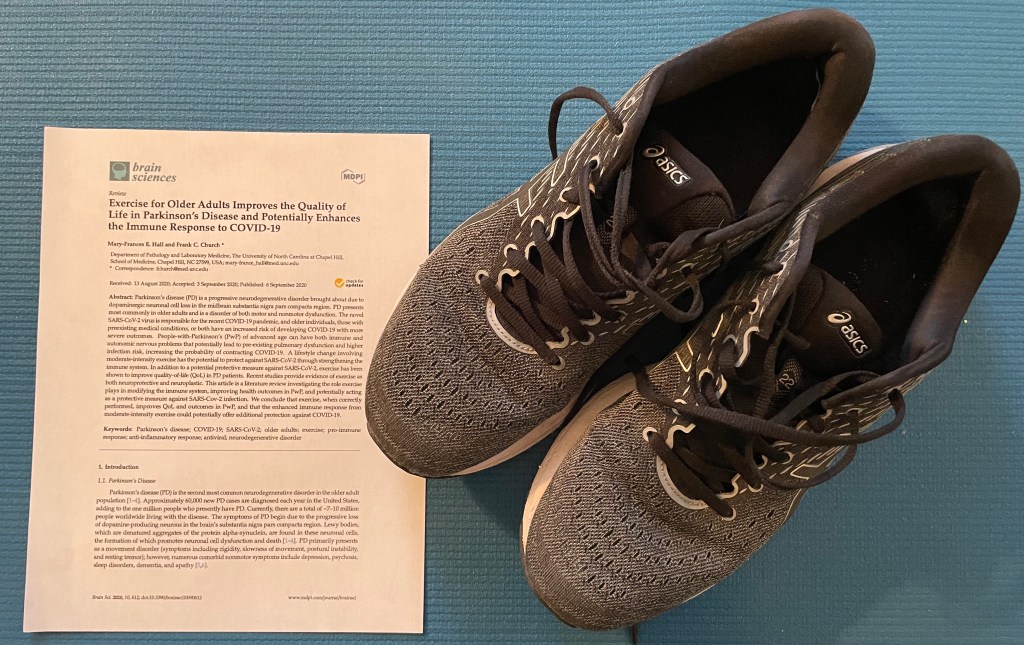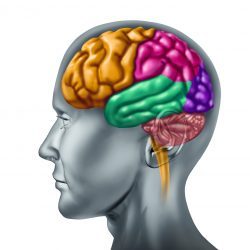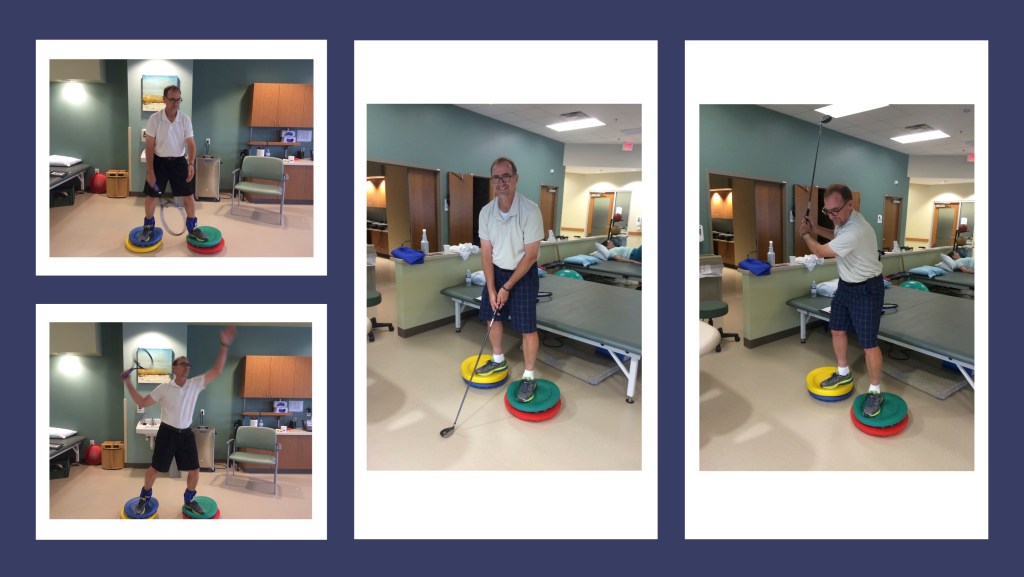“You can’t go back and change the beginning, but you can start where you are and change the ending.” C. S. Lewis
“A single dream is more powerful than a thousand realities.” J. R. R. Tolkien
Introduction: There are a lot of ways one could take the topic of this post, “the balancing act of Parkinson’s.” The story could align with the necessary balance in life with Parkinson’s that deals with health and disease. Furthermore, balance is needed during work in handling our off-on periods from carbidopa-levodopa-related therapy. Maybe it could even include how one balances the effort to treat the disorder’s symptoms. No doubt, these could each be a future topic to discuss in the blog.
However, my intention here is the actual act of staying balanced on your own two feet and preventing falling. I want to write about the increased risk of falling due to Parkinson’s, the physical act of staying balanced and suggest some exercises to practice improving your balance. Stay balanced in both thought and footwork as you navigate this perilous path called life. In older adults and adults with Parkinson’s, the risk of falling is increased; thus, the real reason for practicing a balancing act is to reduce the chance of falling.
There is no doubt you are aware of the numerous negative consequences of falling in older adults. Injuries from falling range from sprains, trauma and bruising, and fractures of major bones (hip, wrist, ankle, and arm), to intracranial hemorrhage (bleeding) that could promote either a stroke or even death.

“Maintain a state of balance between physical acts and inner serenity, like a lute whose strings are finely tuned. ” Gautama Budha.
What is Balance and What Physiological Systems Contribute to Maintaining Balance?: The most concise description of balance is an even distribution of weight enabling someone to remain upright and steady. Your body uses three different physiological systems to maintain or control your balance: namely: proprioception, which is how your body senses its position in terms of spacial recognition; vision; and the vestibular system of the inner ear (this system keeps your vision stable while your head is moving in various directions).
Think about it this way, training all three systems is vital; however, if your eyesight is poorly corrected, that could contribute to falls. If your ears are stopped up, or you are dizzy from being dehydrated, or for any other reason, that could lead to a fall. The failure of one system may contribute to increasing the risk of falling. For instance, if it is late at night and you get up to use the bathroom in the dark, and you can’t see well, clearly, vision will be taken out of the equation to help dictate whether your risk of falling increases in the night.
Posture, balance, and axial mobility are key features to which upright stance, walking, and many daily actions we complete without conscious thinking are performed. Postural instability is an impairment of the ability to maintain posture and balance, compromising the capability to quickly and efficiently maintain and change positions. Postural instability represents one of the most disabling physical symptoms of Parkinson’s due to its association with increased risk of falls, loss of independence, and increased rates of depression among patients. Additionally, freezing of gait, dyskinesia, orthostatic hypotension, visuospatial dysfunction, and poor posture all contribute to an increased risk of falls in Parkinson’s.
“Physical activity promotes high productivity.” Lailah Gifty Akita
Facts About Falling: We recently wrote an article about reducing the risks of falling in Parkinson’s by playing golf (Click here if you are interested in reading this paper). This current blog post does not concern itself with the game of golf, but it does focus on exercises to help keep one balanced. Here are some facts about falling:
•People/Persons-with-Parkinson’s disease (PwP) are nine times more likely to fall compared to age-matched healthy individuals.
*PwP have been reported ~70% report falling yearly, and sadly, 13% report falling weekly.
•Due to the average age of PwP (>65 years old), the same risk factors for falls in older adults without Parkinson’s, include changes in balance and gait, visual impairment, postural hypotension, dementia, neurologic and musculoskeletal disabilities, medications, and environmental hazards.
•Due to the many complications possible from Parkinson’s, all of these problems are magnified, creating a situation where falls are greatly possible in an older adult with Parkinson’s.
•For a more complete review of the various factors that promote falls in older adults with Parkinson’s, please see the references included at the end.
“Life is like riding a bicycle. To keep your balance, you must keep moving.” Albert Einstein
Pathway to Increased Risk of Falling with Parkinson’s: Parkinson’s leads to reduced dopamine synthesis in the substantia nigra region of the basal ganglia. The basal ganglia and the reduction in dopamine contribute to the difficulty in maintaining balance. For those of you without Parkinson’s, balance is an instantaneous reaction. The ultimate issue for those with Parkinson’s is staying balanced. Therefore, one must be vigilant concerning walking, gait changes, stiffness, and changes in brain matter that affect both cognitive and balance issues. Ultimately, taking deliberate steps to counter all of these “pro-fall” parameters from Parkinson’s that promote one to fall is the primary way to help limit the risk of falling and injuring oneself.
“Life is a balance between rest and movement.” Rajneesh
Exercises to Reduce the Risk of Falling: To begin, as you all know, I am not a professional trainer of any sort. I present this material as someone who has always exercised, and now with Parkinson’s, I want to share ideas and routines that have benefited me. In this case, some simple exercises may improve your balance over time, but they need to be done on a regular basis. As with all activities, please consult your Neurologist before beginning this or any new workout.
These are not rigorous or demanding exercises; the focus is on improving your balance. And unlike the more strenuous activities that are neuroprotective, performing these simple exercises is just plain body protective in hopefully preventing you from falling. Thus, I see real merit in presenting these exercises to you.
If you search the internet for senior exercises and balance, there are 100s of examples. Are there any better than others? I’m not sure, but I highlighted a few websites/YouTube videos for you to consult (included near the end).
“The best and safest thing is to keep a balance in your life, acknowledge the great powers around us and in us. If you can do that, and live that way, you are really a wise man.” Euripides
Simple Exercises to (Hopefully) Reduce Your Risk of Falling: If you have read this far, you realize that exercises are good for all older adults; however, these or some sort of exercise routine related to balance improvement is critical for anyone with Parkinson’s.
Standing on One Leg-
Stand on one foot behind a chair, holding on for balance when needed.
Hold this position for up to 15 seconds.
Repeat 10 times.
Switch legs and hold up the other leg and repeat 10 times.
Goals-
(1) increase hold time to 30, 45, and 60 sec (the longer the better);
(2) Try to release your grip from the chair, that is, do it free-standing (but keep the chair close);
(3) Now start over and try it with your eyes closed.
Benefit-
Best exercise (In my opinion) for simply improving balance.
Shifting Your Weight-
Always have a chair near, and begin by standing with your feet hip-width apart.
Shift your weight to one side, then lift your other foot up..
Begin by holding this position for 15 sec.
Return to the standing position and switch legs.
Repeat for both legs 10 times.
Goals-
(1) increase hold time to 30, 45, and 60 sec (the longer the better);
(2) Try to release your grip from the chair, that is, do it free-standing (but keep the chair close);
(3) Now start over and try it with your eyes closed.
Benefit-
Another good exercise for improving balance.
Heel Raises-
Stand behind the back of a chair.
Rise up on your toes and then (if you can) back onto your heels, without bending the rest of your body.
Repeat 10 times.
Goals-
(1) increase reps to 20 and 30.
(2) Try to release your grip from the chair, that is, do it free-standing (but keep the chair close);
(3) Now start over and try it with your eyes closed.
Benefit–
Many of us have tight ankles and doing this exercise will provide some lower body strength and also improve balance.
Forward, Backwards, and Sideways Step and Reach-
Always have a chair near you (if needed).
Starting position- stand tall with arms at your side.
From the starting position, step one leg forward and reach your arms out.
Return to starting position and do each leg 10 times.
From the starting position, step backward with the back leg flat on the ground and the front leg on your heel, reaching arms back, and return to standing start with arms extended to the front.
Return to starting position and do each leg 10 times.
From the starting position, step one leg to the side and reach your arms to the side.
Return to starting position and do each leg 10 times.
Goals and Benefits-
Movement enables better balance, regularly performing these simple step exercises enhances your awareness of self, somewhat helping to stabilize your body.
Stand-to-Sit and Sit-to-Stand-
Standing in front of a chair, throw your arms out and bend your knees, controlling your body’s balance point as you move down to sit (the key is not to flop down).
Return to starting standing position and do 10 times.
Sitting in a chair, reach your arms forward, and with a smooth effort, you lift your body off the chair (this will require some practice).
Return to starting sitting position and do 10 times.
Goals and Benefits- Getting in and off a chair or an automobile seat can challenge one, practicing these two moves together will benefit you greatly. Shown below is a sequence of photos of me performing these exercises (yes, my PT’s were challenging both my ability to remain balanced and my strength by adding wrist/ankle weights. These modifications are only recommended under the guidance of professionally trained and certified personnel!).
Challenge–
Several years ago, using my 2 favorite sports golf and tennis, my two PT’s presented me with these unequal balance devices and asked me to swing my clubs. The goal was to stay balanced while performing the movement. I did slip several times with the PT’s there to stabilize my balance. I would only recommend you do this sort of exercise under strict supervision and guidance by trained and certified professionals.
Goals and Benefits- Maintaining your balance is crucial to not fall. Performing this exercise, in a safe setting, showed me the need to regularly perform the exercises described above.
“Happiness is not a matter of intensity but of balance and order and rhythm and harmony.” Thomas Merton
Balancing Your Life: The overall goal in this long and meandering blog post has simply been to describe some exercises to reduce your risk of falls. It matters not if you follow my suggested routine; what matters the most is that you recognize the need to work on balance. You should begin a program if you have not done so yet, and try to stay with it. Good luck, and remember, be balanced and positive in your approach to these exercises meant to lessen your chance of falls.
“There is no secret to balance. You just have to feel the waves.” Frank Herbert
Selected Videos Demonstrating Balance Exercises to Lessen the Fall Risk:
https://www.youtube.com/watch?v=VHMgkTC9UAc
https://www.healthline.com/health/exercises-for-balance#why-balance-is-important
https://www.lifehack.org/689202/exercise-for-seniors
https://www.mayoclinic.org/healthy-lifestyle/fitness/multimedia/balance-exercises/sls-20076853
Publications Related to Increased Risk of Falls for Older Adults with Parkinson’s:
Bliss, Rebecca R., and Frank C. Church. “Golf as a Physical Activity to Potentially Reduce the Risk of Falls in Older Adults with Parkinson’s Disease.” Sports 9, no. 6 (2021): 72.
Dennison, Andrew C., Joseph V. Noorigian, Keith M. Robinson, David N. Fisman, Heather J. Cianci, Paul Moberg, Lisette Bunting-Perry, Rebecca Martine, John Duda, and Matthew B. Stern. “Falling in Parkinson disease: identifying and prioritizing risk factors in recurrent fallers.” American journal of physical medicine & rehabilitation 86, no. 8 (2007): 621-632.
Dibble, Leland E., and Mark Lange. “Predicting falls in individuals with Parkinson disease: a reconsideration of clinical balance measures.” Journal of Neurologic Physical Therapy 30, no. 2 (2006): 60-67.
Mak, Margaret K., Irene S. Wong-Yu, Xia Shen, and Chloe L. Chung. “Long-term effects of exercise and physical therapy in people with Parkinson disease.” Nature Reviews Neurology 13, no. 11 (2017): 689-703.
Canning, Colleen G., Catherine Sherrington, Stephen R. Lord, Jacqueline CT Close, Stephane Heritier, Gillian Z. Heller, Kirsten Howard et al. “Exercise for falls prevention in Parkinson disease: a randomized controlled trial.” Neurology 84, no. 3 (2015): 304-312.
Hackney, Madeleine E., and Gammon M. Earhart. “The effects of a secondary task on forward and backward walking in Parkinson Disease.” Neurorehabilitation and neural repair 24, no. 1 (2010): 97.
Kerr, Graham K., Charles J. Worringham, Michael H. Cole, Philippe F. Lacherez, Joanne M. Wood, and P. A. Silburn. “Predictors of future falls in Parkinson disease.” Neurology 75, no. 2 (2010): 116-124.
“Humor requires perspective. Perspective requires focus. Focus requires balance. Balance requires attention to the present moment. In the ‘now’ one is freed from labels. Success and failure, good luck and bad—they’re all constructs of your mind.” Tom Bergeron





Thanks Frank for sharing your experience and journey through PD. It’s very helpful and encouraging to other PD patients. Take care.
LikeLike
Thanks Philip, we all just want to provide a path that helps someone wiith PD. I am glad you found this post helpful and encouraging. That matters. Best wishes, Frank
LikeLike